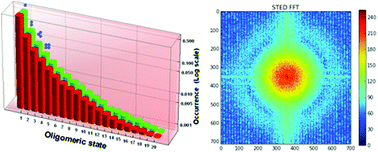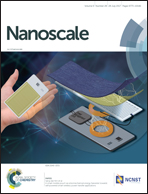Nanoscale clustering of the neurotrophin receptor TrkB revealed by super-resolution STED microscopy†
Abstract
The nanoscale organization of the tropomyosin-related kinase receptor type B (TrkB), a promising therapeutic target for severe neurodegenerative and psychiatric disorders, is examined by stimulated emission depletion (STED) microscopy using the deconvoluted gated STED option. The performed immunofluorescence nanoscopic subdiffraction imaging of the membrane receptor localization reveals that clusters of oligomeric TrkB states and randomly organized nanodomains are formed in the membranes of differentiated human neuroblastoma SH-SY5Y cells, which are studied as an in vitro model of neurodegeneration. Despite that the monomeric (isolated) states of the receptor cannot be distinguished from its dimeric forms in such images, TrkB receptor dimers (or couple of individual monomers) are visualized at super-resolution as single pixels in the magnified Huygens-deconvoluted gated STED images. The clusters of higher-order TrkB oligomers are of dynamic nature rather than of a fixed stoichiometry. The propensity for membrane protein clustering as well as the dissociation of the TrkB receptors nanodomains can be modulated by neurotherapeutic formulations containing ω-3 polyunsaturated docosahexaenoic acid (DHA). Nanomolar concentrations of DHA change the receptor topology and lead to disruption of the cluster phases. This result is of therapeutic importance for TrkB receptor availability upon ligand binding as DHA favours the mobility and the dynamic distribution of the protein populations in the cell membranes.



 Please wait while we load your content...
Please wait while we load your content...